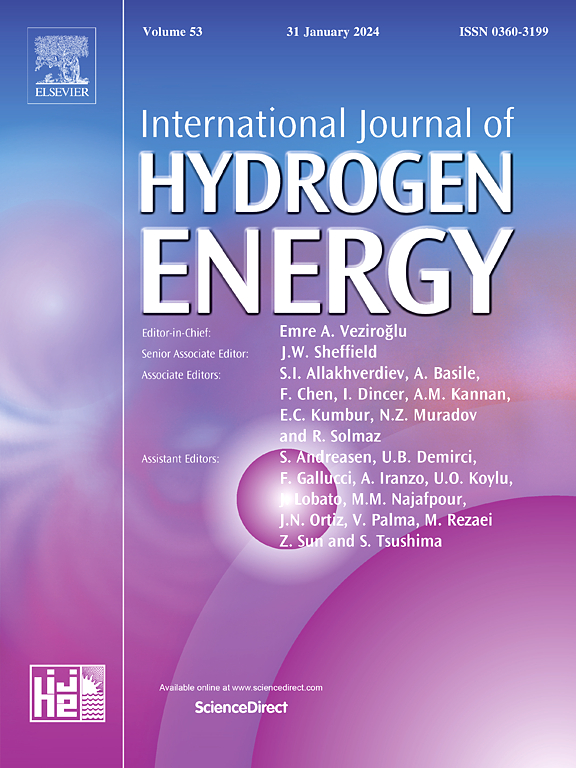Ru/Co3O4纳米片催化尿素助解水的合成
IF 8.1
2区 工程技术
Q1 CHEMISTRY, PHYSICAL
引用次数: 0
摘要
尿素氧化反应是尿素辅助电解制氢的一个很有前途的替代析氧反应。本文通过反溶剂结晶法制备了具有优异尿素辅助电解性能的Ru/Co3O4纳米颗粒(NPs)。Co3O4与Ru之间的强相互作用增强了协同效应,导致活性位点数量增加,电子结构调整,反应动力学增强,结构缺陷增多,从而提高了催化活性和稳定性。Ru/Co3O4/C催化剂具有出色的多功能活性,其析氧反应(OER)和析氢反应(HER)的过电位分别为238 mV和46 mV,并使尿素氧化反应(UOR)在1.45 V下达到10 mA cm−2。令人印象深刻的是,Ru/Co3O4||Ru/Co3O4需要1.47 V的超低电压才能在尿素辅助水电解中提供10 mA cm−2的电流密度,比商用RuO2||Pt/C低190 mV,并且具有优异的稳定性。综合表征技术分析表明,Ru/Co3O4/C具有优异的结构稳定性、可逆的表面氧化还原行为和优越的电荷转移动力学,特别是对于UOR。本研究为尿素辅助水电解节能制氢提供了一种新的策略。本文章由计算机程序翻译,如有差异,请以英文原文为准。

Synthesis of Ru/Co3O4 nanosheets as a multifunctional electrocatalyst for boosting urea-assisted water electrolysis
The urea oxidation reaction offers a promising alternative to the oxygen evolution reaction in urea-assisted water electrolysis for hydrogen production. Herein, Ru/Co3O4 nanoparticles (NPs) with excellent urea-assisted water electrolysis performance were prepared via an antisolvent crystallization-based method. The strong interaction between Co3O4 and Ru resulted in enhanced synergistic effects, leading to an increased number of active sites, adjusted electronic structure, enhanced reaction kinetics, and more structural defects, thus enhancing both the catalytic activity and stability. The Ru/Co3O4/C catalyst delivers outstanding multifunctional activity with low overpotentials of 238 mV for oxygen evolution reaction (OER), 46 mV for hydrogen evolution reaction (HER), and enables urea oxidation reaction (UOR) at 1.45 V to reach 10 mA cm−2. Impressively, an ultralow voltage of 1.47 V was required for Ru/Co3O4||Ru/Co3O4 to deliver a current density of 10 mA cm−2 in urea-assisted water electrolysis, which was 190 mV lower than that of the commercial RuO2||Pt/C couple, with superior stability. Comprehensive characterization techniques analyses reveal that Ru/Co3O4/C exhibits excellent structural stability, reversible surface redox behavior, and superior charge transfer kinetics, particularly for the UOR. This work provides a novel strategy for urea-assisted water electrolysis toward energy-saving H2 production.
求助全文
通过发布文献求助,成功后即可免费获取论文全文。
去求助
来源期刊

International Journal of Hydrogen Energy
工程技术-环境科学
CiteScore
13.50
自引率
25.00%
发文量
3502
审稿时长
60 days
期刊介绍:
The objective of the International Journal of Hydrogen Energy is to facilitate the exchange of new ideas, technological advancements, and research findings in the field of Hydrogen Energy among scientists and engineers worldwide. This journal showcases original research, both analytical and experimental, covering various aspects of Hydrogen Energy. These include production, storage, transmission, utilization, enabling technologies, environmental impact, economic considerations, and global perspectives on hydrogen and its carriers such as NH3, CH4, alcohols, etc.
The utilization aspect encompasses various methods such as thermochemical (combustion), photochemical, electrochemical (fuel cells), and nuclear conversion of hydrogen, hydrogen isotopes, and hydrogen carriers into thermal, mechanical, and electrical energies. The applications of these energies can be found in transportation (including aerospace), industrial, commercial, and residential sectors.
 求助内容:
求助内容: 应助结果提醒方式:
应助结果提醒方式:


